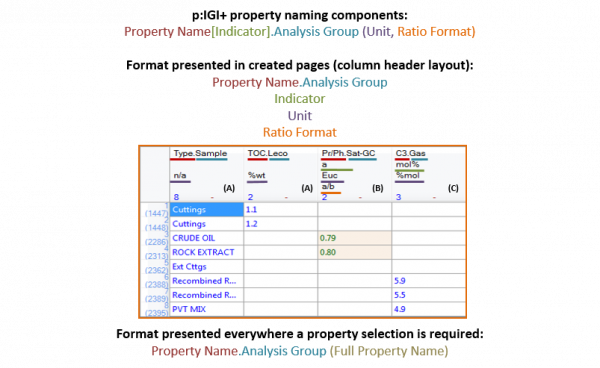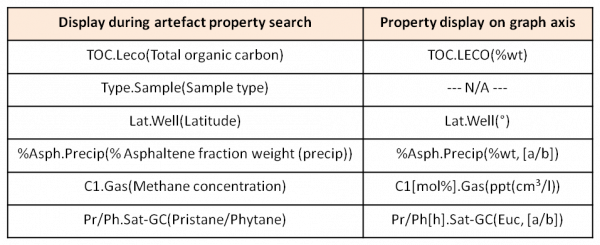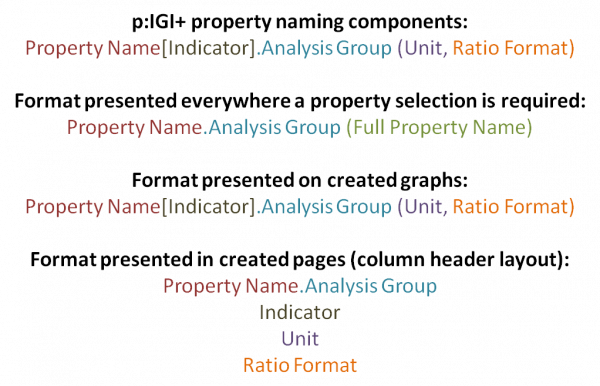Naming in the IGI property model
Overview
We have significantly updated the property model (columns) across the IGI software in Metis and p:IGI+. This page explains the naming choices in the IGI property model.
Usage: Throughout the system, particularly during import and in the property selection dialogues
How to use in practice
At its core the IGI property model has been designed around the commonly utilised analytical techniques available in geochemical labs. Consequently IGI has employed a property naming convention which provides clear differentiation on property name, the analysis employed and the type of measurement made where this is ambiguous.

The p:IGI+ property model naming convention and display format as presented across the software. Not all naming components are necessary for all properties types. Three property types exist within the p:IGI+ property model: A) Standard properties B) Molecular properties and C) Gas properties.
Fig: The IGI data model with individual properties, based on sample type/fraction, associated with a preparative and analytical method.
This fundamental association between property, sample type and associated analytical method/s provides users flexibility when using the IGI property model. Three property types exist within the IGI property model:
- Standard properties - things that are measured and produce a single value, such as total organic carbon, visual kerogen abundances, isotopic composition, bulk properties such as density etc.;
- Molecular properties - detailed chemical composition of the sample, typically obtained using some form of chromatography and potentially mass spectrometry which can be measured in several ways including as peak heights or areas;
- Gas properties - typically quite coarse (but increasingly more refined) analysis of gas composition often measured by a combination of gas chromatography and flame ionisation, typically resolved into either a volume, mass or mole fraction.
Property Component Elements
The complete property description thus comprises a number of elements:
- Property - A particular aspect of a sample (often a physical or chemical characteristic) on which a measurement is made, e.g. TOC, nC10 concentration, vitrinite reflectance (%Ro). The property name is given using a short naming convention in most places.
- Full Property Name - A longer description of the property including key molecular arrangements which is available for reference during property search to assist unambiguous identification, and in the geochemical help.
- Analysis Group - The associated procedure / analytical technique by which a samples specific properties are measured, e.g. LECO, WO-GCMS, Microscopy in Transmitted or Reflected light.
- Indicator - Molecular and gas data properties can be measured in different ways:
-
-
- Molecular data: can be provided as peak heights [h], peak areas [a], concentrations derived from heights [ch] or areas [ca], or can come from an unknown [un] measurement, if only a value is provided with no context.
- Gas data: can be given as mass [mass], volume [vol] or mole [mol] fractions, or can come from an unknown [un] measurement, if only a value is provided with no context.
-
The IGI property model has the capacity to store data relating to several indicators simultaneously, as labs will often provide e.g. GCMS data in both heights and areas, and increasingly as concentrations derived from heights and areas. There is no clear agreement on which form of measurement should be preferred, so we offer the ability to store all the data, enabling context dependent selection of which indicator to use.
- Unit - a well defined system used to quantify / provide meaning to the result of a particular measurement, e.g. %wt, degrees centigrade, micrograms per gram.
- Ratio - for many equations, e.g. Pristane/Phytane, we need to specify whether the ratio is given in un-normalised (a/b) or normalised (a/(a+b)) form. The ratio is independent of the unit.
A consistent formatting of property information is used during property search and display on artefacts in the system, e.g. graphs, pages, statistics etc. The unit Euc stands for the Euclid, a natural non-dimensional unit. Examples are shown below:

At present there are over 70 analysis groups with cumulatively more than 6000 properties in the IGI property model. This is continually under review and new analysis groups and the properties are expected to be added in future versions.
The analysis groups present as of version 1.14.0.x are shown below:

Video tutorials
None Available

